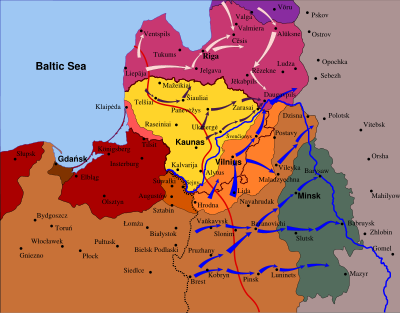- Operation Minsk
-
Operation Minsk Part of Polish-Soviet War[1] Date Early August, 1919 Location Near Minsk, Belarus Result Polish victory Belligerents  Poland
Poland Bolshevist Russia
Bolshevist RussiaCommanders and leaders  Stanisław Szeptycki
Stanisław SzeptyckiUnknown Strength 14,000 men
40 gunsUnknown Casualties and losses Unknown Unknown, but heavy - Target Vistula
- Bereza Kartuska
- Pińsk
- Lida
- Vilna
- Minsk
- 1st Berezina
- Daugavpils
- Latyczów
- Mozyr
- Korosteń
- Koziatyn
- 2nd Berezina
- Kiev
- Wołodarka
- Głębokie
- Mironówka
- Olszanica
- Żywotów
- Miedwiedówka
- Dziunków
- Wasylkowce
- Bystrzyk
- 1st Brześć
- 1st Grodno
- 1st Niemen
- Boryspol
- Auta
- Dubno
- Kobryn
- Łomża
- Brody
- Dęblin
- Nasielsk
- Serock
- Radzymin
- Ossów
- Warsaw
- Płock
- Wkra
- Cyców
- Ciechanów
- Lwów
- Zadwórze
- Mława
- Białystok
- Komarów
- Dytiatyn
- 2nd Niemen
- 2nd Grodno
- 2nd Brześć
- Mołodeczno
- 2nd Minsk
Operation Minsk refers to the Polish offensive and capture of Minsk from the Bolshevik control in early August 1919.
In the summer of 1919 after the Polish successes in several Polish-Russian skirmishes, the two combatants (both engaged on multiple fronts) have been near the limits of their capabiity to wage warfare with each other; they needed time to regroup and concentrate their forces. However the Polish High Command intended to strike one more blow against the Bolsheviks while the Polish forces were on the offensive: they decided to cripple the Western Army (Russia) (Soviet Western Division), headquartered in Minsk, and further damage Soviet logistics by taking control of this important railway center.
In July, Polish forces (the 'Northern Group') under general Stanisław Szeptycki (whose officers included Władysław Anders, Jozef Lasocki and Stefan Mokrzecki) were strengthened to 12,000 infantry, 2,000 cavalry and 40 guns. Polish plan involved a wide pincer movement around the city of Minsk. The battle raged throughout the first week of August. Soviet forces took heavy casualties and Minsk fell to the Poles on August 8.
The success of the Polish offensive allowed the Poles to move forward again, and by the end of August Józef Piłsudski ordered his armies to stop, as he considered all territories important to Poland - and feasible to take before winter - secured.
References
- Inline
- ^ There is no universal agreement on whether this conflict was a part of the Polish-Soviet War. See a section devoted to this subject in the Polish-Soviet War article.
- General
- Davies, Norman, White Eagle, Red Star: the Polish-Soviet War, 1919–20, Pimlico, 2003, ISBN 0-7126-0694-7. (First edition: New York, St. Martin's Press, inc., 1972.), pages 58–60
Categories:- 1919 in Poland
- Battles of the Polish–Soviet War
- History of Minsk
- Belarusian history stubs
- Polish battle stubs
- Russian battle stubs
Wikimedia Foundation. 2010.

